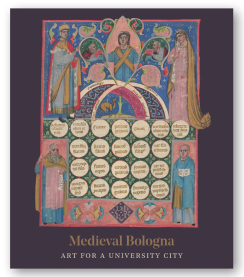- EAN13
- 9781911300816
- Éditeur
- Paul Holberton Publishing
- Date de publication
- 5 novembre 2021
- Nombre de pages
- 224
- Dimensions
- 28,8 x 25 x 2,2 cm
- Poids
- 1370 g
- Langue
- fre
Medieval Bologna: Art For A University City
Kennedy Trinita
Paul Holberton Publishing
Prix public : 50,00 €
Accompanying an exhibition at the Frist Art Museum, this lavishly illustrated catalogue is the first major study in English about manuscript illumination, painting, and sculpture in the northern Italian city of Bologna between the years 1200 and 1400. By focusing on Bologna, Europe’s first university city, this publication aims to expand our understanding of art and its purposes in the medieval world. Universities are a medieval invention, and Bologna has the distinction of having the oldest one in Europe. Its origins have been traced to the late eleventh century, when masters and students started gathering in the city to study Roman law. The academic setting gave rise to Bologna’s unique artistic culture. Professors enjoyed high social status and were buried in impressive tombs carved with classroom scenes. Most importantly, teachers and students created a tremendous demand for books. By the mid-thirteenth century, the city had become the preeminent center for manuscript production in Italy. Most books were made outside traditional monastic scriptoria, within a revolutionary commercial system involving stationers, parchment makers, scribes, illuminators, and clients. A new style of script, called the littera Bononiensis, distinguished Bolognese books, and the city’s illuminators were celebrated in Dante’s Divine Comedy. The legal textbooks produced in great numbers in the city are remarkable for their heft and size. In addition to illuminations, which include colorful narrative scenes, these manuscripts often contain in their margins the notes, corrections, and doodles of their original owners. The seven essays in this publication—by academics, a conservator, curators, and a museum educator—create a rich context for the nearly seventy works of art in the exhibition, which are drawn primarily from American libraries, museums, and private collections. Many of these works have never been studied in depth or published before. The authors explore medieval Bologna—its porticoed streets, towers, communal buildings, main piazza, and mendicant churches—and how the city became a center for higher learning at the end of the Middle Ages. They describe the way books were made there, including identifying the pigments used by illuminators. The authors also discuss the illustrious foreign artists called to work in the city, most notably Cimabue and Giotto; the devastating impact of the Black Death; and the political resurgence of Bologna at the end of the fourteenth century that led to the construction of the Basilica of San Petronio, one of the largest churches in the world, in honor of the city’s patron saint.


















